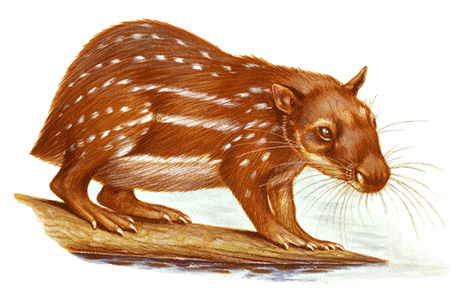Paca, << PAH kuh or PAK uh, >> is a large rodent found in the tropics of North and South America. Pacas measure 241/2 to 321/2 inches (62 to 83 centimeters) long. Most pacas weigh 14 to 22 pounds (6.3 to 10 kilograms).

Pacas have a small, thick head; stout body; short, slender legs; and short tail. There are five long toes on each back foot and four on each front foot. Pacas are covered with rough, brownish or black hair. Four rows of white spots line each side of their body. Pacas have unusually large cheek pouches. The pouches form roomy chambers that help the animal make sounds.
Pacas are found from central Mexico south to Paraguay, and in the Andes Mountains of Venezuela, Colombia, and Ecuador. They live in forests, usually near rivers. Pacas are good swimmers and often escape from enemies by water. Most pacas live alone in burrows, caves, woodpiles, stumps, or rocks. Most females produce two litters a year of one or two young.
Pacas come out for food only at night. They eat plants, roots, seeds, and tropical fruit. Pacas also sometimes eat such crops as sugar cane, corn, and yams, and are often hunted in areas where these crops grow. Hunters also kill pacas for their tasty flesh, which is eaten. Wild dogs and ocelots also prey on pacas.
See also Agouti.
